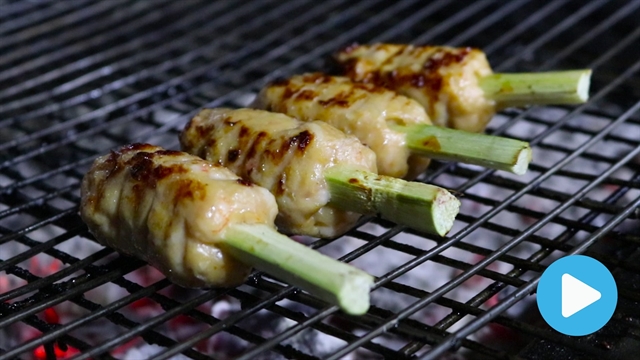The dish is also called giò me by locals to differentiate it from other kinds of cured meats, said Phan Van Toan, a cured veal maker from Nghe An’s Nam Dan District.
“Elderly people said no one can remember when giò me came into being but it is an original name used by our local ancestors from a long time ago,” he said.
The dish is made in the province’s Nam Dan’s Nam Nghia Village where calves are raised in the mountains so the meat is light pink, firm and savoury, Toan said.
 |
| A plate of tasty and delicious giò me (cured veal meat) that attracts a lot of customers inside and outside the country. Photo vifoodshop.com |
Giò me is made from unground lean veal which is often cut into big or small pieces.
Toan said ingredients to make the dish include 1kg of veal, 0.2kg of veal skin, two chicken eggs, ½ tsp of baking soda, 2 tsp of pepper, one piece of garlic, one piece of ginger and some banana leaves.
After cleaning the veal, it is soaked in 800ml of white wine for 15 minutes to remove any bad smells. This helps to make the dish tastier, said Toan, adding that should be turned regularly during the process to ensure a thorough soaking. The meat is then cleaned with water again and tissues are used to absorb any moisture from the meat.
The next step is to cut into the meat and soak it in the above-mentioned ingredients for at least three hours, said Toan, noting that several makers prolong the soaking through a night to make the cured meat more delicious.
 |
| Steamed cured veal meat is more enjoyable compared with that of boiled method. Photo vifoodshop.com |
Next, the cook has to stir the eggs well before frying them into a thin form before grinding the veal skin into a puree and then adding a teaspoon of quality fish sauce to give the puree a rich flavour before.
Then, they spread the eggs as the first layer, then the veal skin puree as the second layer on a fresh banana leaf before placing the soaked meat in the middle of these layers. Next, they must roll it firmly and carefully tie it with a bamboo string, said Toan.
He said steamed cured veal meat is tastier but it needs at least 6-7 hours compared with boiling which takes only four hours.
 |
| Young calve meat should be cut into a certain-size pieces before soaking them with needed ingredients such as fish sauce, pepper and others. Photo eva.vn |
He warned that makers should ensure they add more boiled water to stop the pot from being burned, which could cause the paste to lose its flavour.
To preserve the dish it should be kept in the refrigerator. Before enjoying, eaters should cut the meat into medium slices and dip with chilli sauce, Toan added.
 |
| Workers are wrapping up the cured veal meat at a private company in Nghe An's Nam Dan District. Photo baobariavungtau.com.vn |
Dinh Thi Kim Thoa, whose native village is in Nam Dan District, has lived in the southern province of Ba Ria-Vung Tau for several decades and said she and her family love giò me. In the past, she had to ask her relatives to send her several kilos of the dish, but for the last 10 years, the dish has been sold locally.
“We enjoy it every week because the handmade meat is produced in the traditional way without any preservatives or colourings but with natural characteristics. Compared with other cured meats, giò me is spicy with an attractive flavour,” Thoa said.
Thoa said her friends in Hanoi are interested in the dish and sometimes travel to Nghe An to enjoy it.
Source: Vietnam News

Vietnamese food: Fried tofu sandwich
Here’s a sandwich like no other. Instead of bread, tofu is used to create the snack. This relatively new dish is taking HCM City by storm. And with a wide choice of fillings it’s a must try for anyone looking for a tasty treat.

Vietnamese food: Shrimp paste with sugarcane
Chạo tôm (grilled shrimp paste wrapped around sugarcane) used to be served to royalty in central Vietnam.